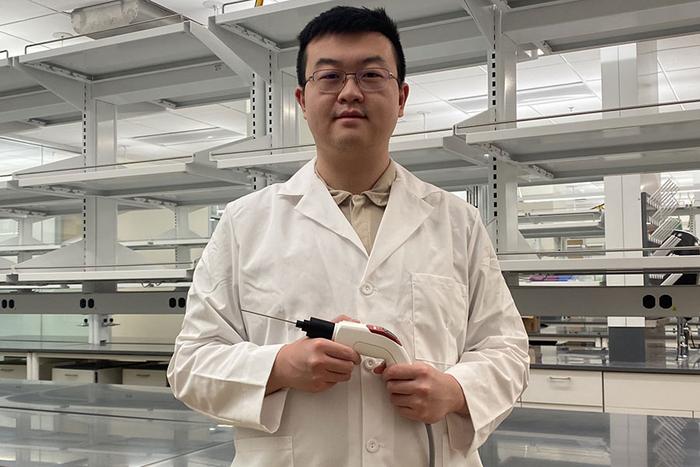Advancements in Kidney Cancer Biopsy Techniques: The Role of Optical Coherence Tomography
In the landscape of medical research, innovative methodologies continue to enhance diagnostic capabilities, particularly in the realm of oncology. Recent developments in kidney cancer biopsy procedures, led by researcher Chen Wang, Ph.D., at the University of Oklahoma’s Biophotonic Imaging Laboratory, reveal promising advancements. Dr. Wang has received a fellowship from the Prevent Cancer Foundation, emphasizing his commitment to improving diagnostic outcomes for kidney cancer patients through novel imaging techniques.
Dr. Wang’s work focuses on developing an optical coherence tomography (OCT) probe, which offers localized imaging in proximity to the biopsy needle. This innovative approach addresses the limitations posed by traditional ultrasound imaging, which has been the standard for kidney tissue visualization. Conventional ultrasound technology often fails to provide precise information regarding the location of the biopsy needle tip, leading to challenges in distinguishing vital anatomical structures, such as blood vessels and tumor margins.
The optical coherence tomography technique stands out by providing real-time imaging right at the needle’s tip, offering a significant advantage during biopsies of small tumors, often only two to three millimeters in size. As Dr. Wang states, the OCT probe facilitates a direct line of sight, thus potentially reducing the number of failed biopsies—a prevalent issue in kidney cancer diagnostics. Historically, approximately 14% of kidney biopsy procedures have not yielded sufficient tissue for diagnosis, necessitating repeat biopsies and causing distress for patients who face the anxiety of undergoing invasive procedures multiple times.
To understand the implications of this research, it is crucial to recognize the existing biopsy methodologies. The reliance on traditional ultrasound imaging is fraught with obstacles, particularly in accurately visualizing the intricate relationship between the biopsy needle and the target tumor. By improving imaging capabilities, the OCT probe seeks to minimize uncertainty during the biopsy process, ultimately enhancing the likelihood of obtaining adequate tissue samples and expediting the diagnosis of kidney cancer.
Additionally, the ability of the optical coherence tomography system to visualize blood vessels introduces the potential to further refine procedural safety. This capability could significantly reduce incidences of renal hemorrhage, a serious complication that can arise during kidney biopsies. By equipping surgeons with enhanced visibility of vascular structures, the OCT probe aims to mitigate risks associated with needle-based interventions.
Wang’s research holds the promise of addressing critical challenges associated with early and accurate detection of kidney cancer, a disease characterized by rising incidence rates according to the American Cancer Society. With advancements in diagnostic procedures like these, there is a heightened potential for impacting health outcomes positively, not only for patients in need of biopsies but also in the broader context of kidney cancer management.
The results from a comprehensive 16-year analysis from a national biopsy laboratory underscore the importance of improving kidney biopsy approaches. When effective imaging technologies are integrated into clinical practices, the enhancement in diagnostic accuracy can lead to a substantial decrease in interventions that fail to procure sufficient diagnostic tissue. This advancement is particularly important in light of kidney cancer’s rising prevalence and the critical need for swift and accurate treatment responses.
The significance of Dr. Wang’s work transcends technical improvements; it also resonates deeply with the patient experience. The anxiety associated with repeated biopsies, coupled with the potential for complications, emphasizes the importance of reliability in diagnostic processes. As the medical community continues to innovate, the focus remains on delivering patient-centered care that prioritizes accuracy, safety, and comfort during medical procedures.
Through this fellowship, Dr. Wang is not only advancing his research but also contributing to the broader initiative of medical innovation aimed at combatting cancer. The implications of such work are profound, potentially positioning the University of Oklahoma at the forefront of kidney cancer diagnostics and treatment methodologies. The optical coherence tomography probe represents a fusion of technological innovation and clinical necessity, promoting the principal objective of improving patient outcomes and ensuring more effective treatment paths in oncology.
As Dr. Wang’s research progresses, it will be crucial for both medical professionals and stakeholders in the healthcare sector to closely follow these developments. The integration of enhanced imaging technologies into clinical practice will undoubtedly shape the future of kidney cancer diagnostics and influence protocols surrounding biopsy procedures. The aspiration is to transform how kidney cancer is diagnosed and treated, ultimately leading to better prognoses and an elevated standard of care for patients confronting this formidable disease.
Subject of Research: Optical coherence tomography in biopsy procedures for kidney cancer.
Article Title: Advancements in Kidney Cancer Biopsy Techniques: The Role of Optical Coherence Tomography.
News Publication Date: October 2023.
Web References: https://tanglab.oucreate.com/, https://preventcancer.org/, https://www.cancer.org/cancer/types/kidney-cancer/about/key-statistics.html.
References: None available.
Image Credits: Credit: University of Oklahoma.
Keywords: Medical imaging, Biopsies, Kidney cancer, Cancer research, Optical coherence tomography.
Tags: biophotonic imaging laboratoryDr. Chen Wang researchimaging breakthroughs in oncologyimproving cancer diagnostic outcomesinnovative medical imaging methodskidney cancer biopsy techniqueslocalized imaging biopsy techniquesoptical coherence tomography advancementsPrevent Cancer Foundation fellowshipreal-time imaging for biopsiessmall tumor detection technologyultrasound imaging limitations





